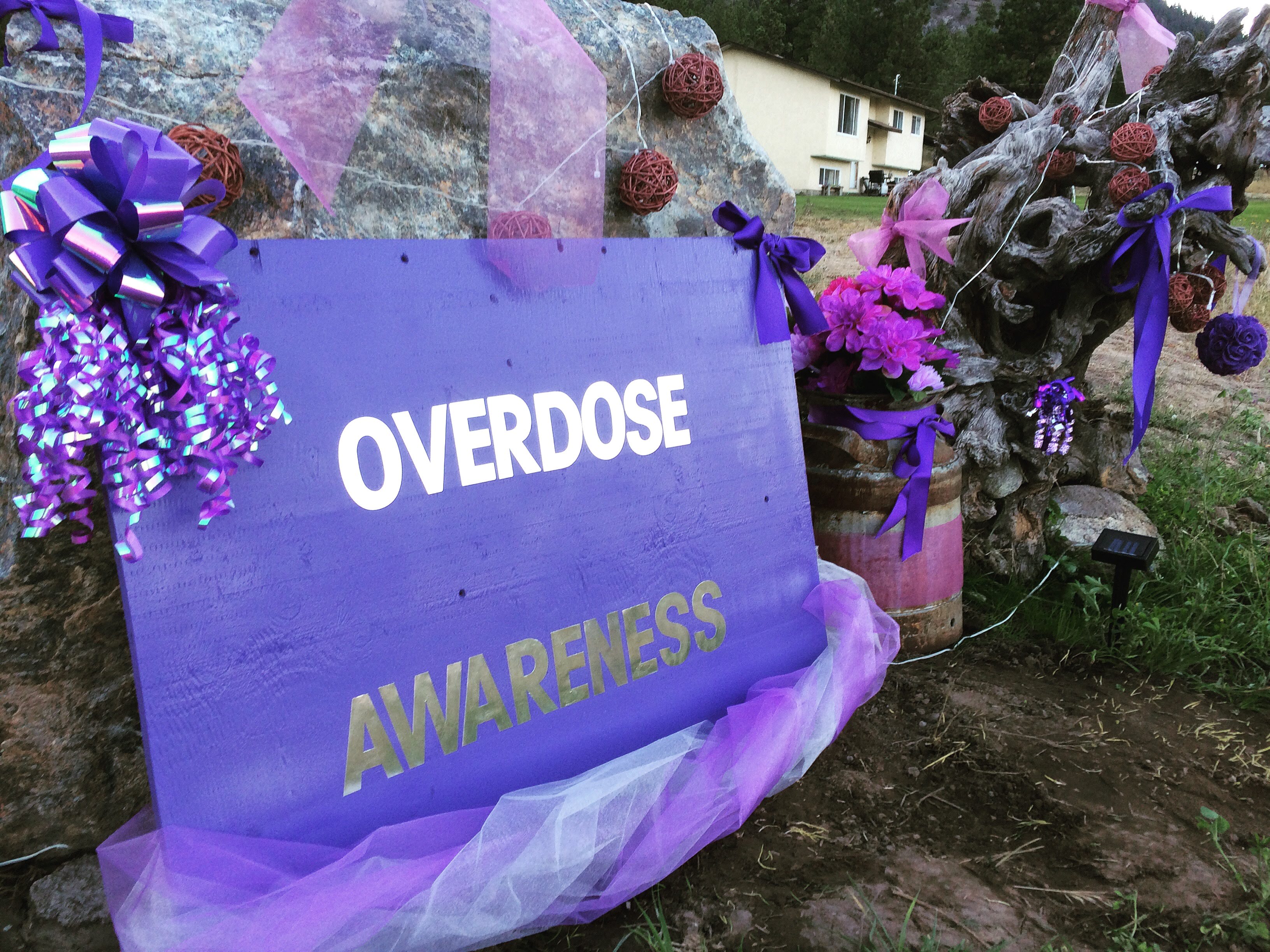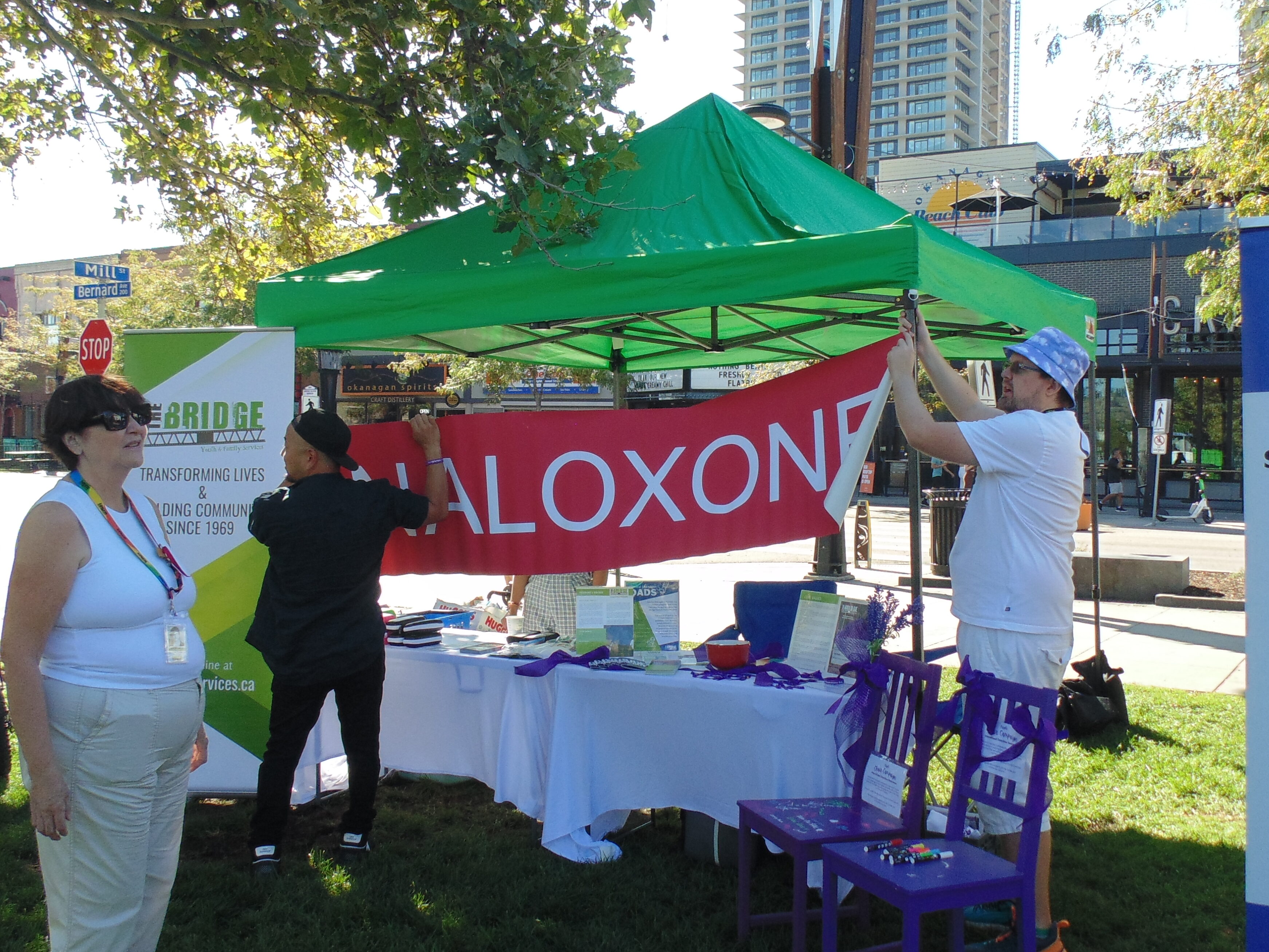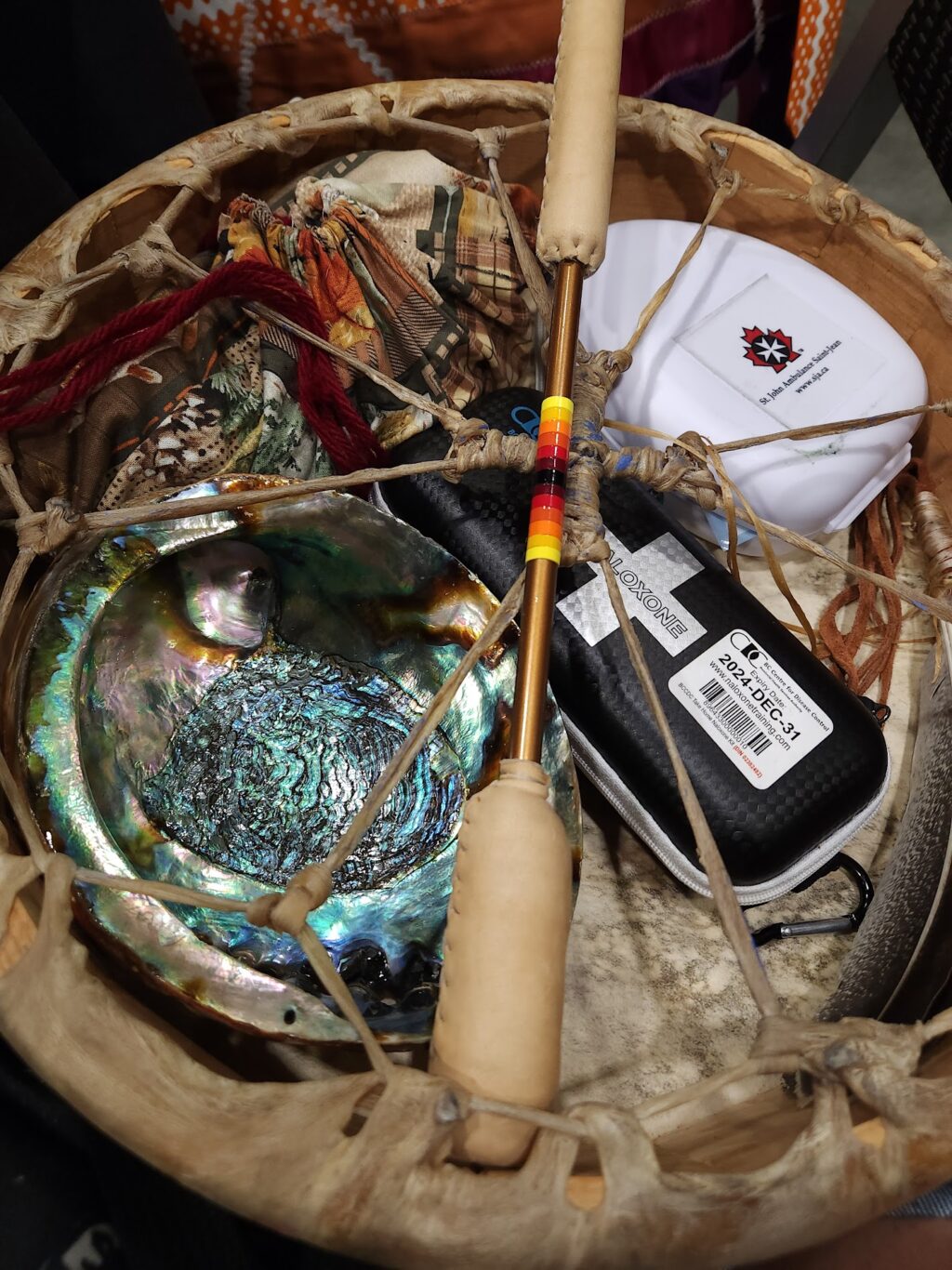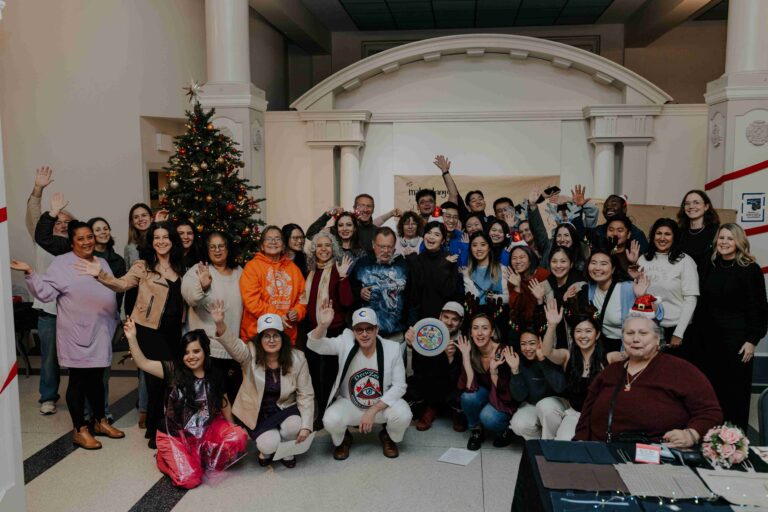
27 August 2025
International Overdose Awareness Day 2025
BY ALYXANDRA LEZARD, BA, INDIGNEOUS WELLBEING PRACTITIONER
Wrapping Our Yard Posts in Purple
On August 31st, 2018, I drove through my community, Penticton Indian Band, and as I was driving, I noticed little purple ribbons tied across the fence of the playground, and again across the people’s yard posts and mailboxes. I saw purple signs with messages of hope. It was like my whole 7-minute drive was fluttering with little purple butterflies all along my path.
On this day, my community, like many others across the world, was commemorating International Overdose Awareness Day, a global campaign dedicated to raising awareness about overdose, reducing stigma around substance use, and remembering those we have lost to toxic drugs.
The support and love from the community was palpable. Grieving the loss of someone to toxic drugs can feel isolating, due to the lack of understanding and assumptions around substance use and substance use-related harms. Showing our support for those we have lost on this day is more than raising awareness; it’s about showing people they are loved, that their loss is real, and reducing stigma about drug-related deaths. Just like wrapping our yard posts in purple, showing support for International Overdose Awareness Day is about making our care visible. It reminds us that real people are behind this crisis, and that families and communities are being greatly impacted by this crisis.
Toxic Drug Crisis in BC
In 2016, the BC Provincial Health Officer declared that drug-related overdose deaths were a public health emergency. At that time, BC had seen 474 overdose deaths in 2015.[1] By 2024, that number has risen to 2,306 deaths, almost 5 times higher than when the crisis was declared.[2]
Illicit drug toxicity is now the second leading cause of potential years of life lost—surpassed only by malignant cancers—and is the fourth leading cause of death overall.[3] For those ages 19-39, it is the leading cause of death.[4]
This crisis also disproportionately impacts Indigenous peoples. In BC, First Nations people are 6.7 times more likely to die from a toxic drug poisoning than other BC residents, and First Nations women are 11.6 times more likely to die than other female residents.[5]
These numbers are staggering. Each number is a sibling, friend, parent, partner, and loved one. They remind us of the urgency and scale of this crisis. And this is why we still need to be talking about the toxic drug crisis, still supporting those who have lost loved ones, and wrapping our arms around those who are using substances. We need to stand together to take meaningful action.

Systems and Community Response
This overdose crisis is not an individual failure; it is a complex public health and systems issue, and communities are stepping up in many ways, including through teams of local organizations and by implementing targeted and innovative solutions.
Community Action Teams
The Community Action Teams (CAT) are collaborative groups of diverse interest holders, including the health sector, non-profit, business, Indigenous organizations, local government, and people with lived and living experience (PWLLE) of substance use. Members of the CATs work together to coordinate local efforts and create practical solutions to the toxic drug crisis. Their work is rooted in relationship building, harm reduction, cultural safety, and equity, with the goal of ensuring everyone has access to resources and supports and to foster communities where stigma is reduced and people feel safe and valued.
Central Okanagan CAT
The Central Okanagan CAT is a part of this province-wide network. Over the years, the group has supported the development of initiatives that support the goal of reducing toxic drug-related harms. In 2024, the group has funded and supported peer employment opportunities through four organizations, creating roles that center lived experience and provide direct support to those navigating complex systems like health, mental health, housing, and recovery. Having PWLLE as points of contact in these systems offers hope, guidance, and empathy for those accessing services.
The work done through the collaboration of the CAT tables has a lasting impact, not just for those directly affected by the toxic drug crisis, but for everyone in the community. By working together as a united front, they can address the overdose crisis in a meaningful way and create a safer, healthier community for all.
Culture as Harm Reduction
As mentioned previously, this crisis disproportionately impacts Indigenous people, and so to meaningfully address this means taking innovative steps that centre Indigenous-specific and Indigenous-led solutions that integrate culture, traditional knowledge, and lived experience.

Knknxtəwix̌ Indigenous Harm Reduction
The knknxtəwix̌ (We Walk Hand in Hand) initiative is a transformative response to the toxic drug poisoning crisis affecting the urban Indigenous communities in the Central Okanagan area. Through culturally safe, trauma-informed, and community-led approaches, the program helps Indigenous peoples access services and overcome systemic challenges. Grounded in Indigenous Ways of Knowing and supported by partnerships, it has fostered meaningful connections between healthcare providers and Indigenous communities.
This initiative focused on three areas:
- Relationship-Building Workshops with the Health Care Sector to support shifts in service delivery, decolonized health practices, and culturally safe experiences for Indigenous people
- Substance Use Day Program Pilot centred Indigenous-specific program that centres Indigenous worldviews, practices, perspectives, and strategies for managing substance use. A program fused with culture, on the land learning, connection to identity, and understanding the root causes of substance use as it relates to colonial histories and harms.
- Outreach and Harm Reduction Services provided service navigation, outreach, other supports and culturally grounded care in partnership with other local services.
The knknxtəwix̌ demonstrates the power of Indigenous-led solutions and collaboration. By integrating lived and living experiences, culture, and harm reduction, the program supported systems change, community wellness, and equity.
What We Can Do
While systems solutions are critical, each of us also has a role to play in shaping the culture around substance use. International Overdose Awareness Day is not only a time to remember those we have lost, but it is also an opportunity to take action. Knowing where to start in complex issues such as this can feel overwhelming; however, there are many concrete ways in which you can make a difference.
Words Matter: Language as Action
Stigma is one of the biggest barriers faced by people who use substances. Stigma towards people who use substances is a pattern of negative assumptions and judgements that can make it harder for people to access support and can add to the challenges they already face.[6] It puts them at a high risk of using substances alone or hiding their substance use from others. It affects their ability to find housing and jobs, lowers the quality of care they receive, and discourages them from seeking necessary health and social services.
A major perpetuator of stigma is language. The way in which we talk about substance use can either reinforce the negative perceptions and harm or open the door for compassion. Language is a tool not only for the way we speak, but how we think. Person-first language, such as “a person who uses substances,” puts the individual before the behaviour, illness, or disorder. It reminds us that people are more than their substance use. Before speaking about substance use, consider: are my words supporting people to feel seen, valued, and understood?
Changing our language changes the framework of the conversation, helping to shift attitudes, reduce stigma, and create a space for care and connection. Each conversation and every word is an action and a chance to show respect and care for others in our community.
For more information on language, see Words Matter: Preferred Language for Talking About Addiction | National Institute on Drug Abuse (NIDA).
“Nothing About Us, Without Us”
A phrase that has recently gained my attention has been “qualified by lived experience,” because it captures an essential truth: people’s lived experiences are a form of expertise. This qualification of experience offers insight into situations and perspectives only understood by those who have been there and understand what it feels like from the inside, and these perspectives are invaluable for shaping effective and relevant approaches.
Uplifting the voices of PWLLE is another way in which organizations, municipalities, health authorities, and so on can contribute to meaningful change in the toxic drug crisis. By really listening to and acting on the reflections, insights and ideas from PWLLE, we can begin to create solutions that are more impactful and grounded in lived truth.
Engaging with PWLLE is more than just hearing someone’s story; it is about working alongside them to shape solutions. The phrase, “nothing about us without us”, affirms the right of the individual to have their experiences guide conversations and decisions that impact their lives. Solutions informed by lived experience are community-driven, meaningful, and reflective of real needs.
The benefits of including people with lived and living experience are:
- Ensuring programs are relevant and reflect the actual needs of the people using the services
- Reduced unintended consequences by hearing people’s experiences accessing services
- Enhance a program, initiative or research project’s credibility and legitimacy
- Increases buy-in. People are more likely to engage in programs and initiatives they helped shape.[7]
Before moving forward, consider who is affected, whose voices are included, and how power is shared. This reflection ensures engagement is thoughtful, intentional, and impactful. It helps shape programs, policies, and initiatives that are genuinely responsive, equitable, and grounded in lived experience.
For more information, visit Peer Engagement Principles and Best Practices.
Getting Involved
Another way you can support International Overdose Awareness Day is by attending an event this week (August 31st) or simply being visible in your support. You can post on social media, share resources, get trained in and carry naloxone, and you can even wrap your yard posts—and hearts—in purple. As I mentioned earlier, showing solidarity with families, those who have lost, and those using substances lets people know they are not alone, and that there are many who stand beside them in this cause.
This year’s theme for Overdose Awareness Day, “we are one big family, driven by hope,” reminds us that we are connected not by our losses, but by our collective strength. This hope is found in our collective actions as community members, family, service providers, leaders, change makers, and in how we choose to stand together.

Other Resources
- https://www.overdoseday.com/
- https://www.momsstoptheharm.com/
- https://towardtheheart.com/
- https://lifeguarddh.com/
- https://towardtheheart.com/naloxone-training
- https://www2.gov.bc.ca/gov/content/health/mental-health-and-addictions/bc-response-to-the-toxic-drug-crisis
[1] Provincial Health Officer declares public health emergency. (2016, April 14). BC Government News. Ministry of Health, Office of the Provincial Health Officer. https://news.gov.bc.ca/releases/2016HLTH0026-000568
[2] BC Centre for Disease Control. (n.d.). Unregulated Drug Deaths BC [Power BI dashboard]. https://app.powerbi.com/view?r=eyJrIjoiOTRlYmI1NzQtZDhiYy00N2EyLTk2YTktMjQwZjRhYjIyMWVjIiwidCI6IjZmZGI1MjAwLTNkMGQtNGE4YS1iMDM2LWQzNjg1ZTM1OWFkYyJ9
[3] BC Centre for Disease Control. (n.d.). Mortality context shiny app [Data visualization tool]. https://bccdc.shinyapps.io/Mortality_Context_ShinyApp/
[4] BC Centre for Disease Control. (n.d.). Mortality context shiny app [Data visualization tool]. https://bccdc.shinyapps.io/Mortality_Context_ShinyApp/
[5] First Nations Health Authority. (2025). First Nations and the toxic drug poisoning crisis in BC: January–December 2024. https://www.fnha.ca/Documents/FNHA-First-Nations-and-the-Toxic-Drug-Poisoning-Crisis-in-BC-Jan-Dec-2024.pdf
[6] National Institute on Drug Abuse. (2022, June). Stigma and discrimination. National Institutes of Health. Retrieved August 21, 2025, fromhttps://nida.nih.gov/research-topics/stigma-discrimination#stigma
[7] Greer, A.M., Amlani, A.A., Buxton, J.A. & the PEEP team. (2017). Peer Engagement Best Practices: A Guide for Health Authorities and other providers. British Columbia Centre for Disease Control. http://www.bccdc.ca/resource-gallery/Documents/PEEP%20Best%20Practice%20Guidelines.pdf




